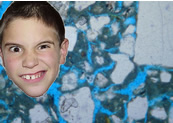
| "My
hope is built on nothing less than Jesus' blood and righteousness"
- the words from the spiritual hymn The Solid Rock written by Edward
Mote (1797-1874). The music, added by William Bradbury (1816-1868),
gave the hymn more intense effectiveness as any melodious song can
do when complementing written lyrics. However, Bradbury didn't add
his tune until 29 years after the lyrics were first written, which
brings me to the realization that certain great thoughts and truths
may lie dormant until someone amplifies their simple, yet profound,
message. The message for me, as it relates to the simple truth about historic brick and stone mortar, was profoundly amplified by M. William Revie of Construction Materials Consultants located in Stirling, Scotland. When I saw his thin section photography of popular mortar mixes, I felt I saw the proverbial "picture worth a thousand words." My kids' faces are pasted on each one. More about this later. |
 |
 |
|||
| 1 part Portland cement to 3 parts sharp sand. A Shrinkage crack is visible in blue. | ||||
 |
||||
| 1 part Natural Hydraulic Lime (NHL) #3.5 to 3 parts sharp sand. This mix contains the NHL that we sell and is accepted worldwide by knowledgeable conservators as an excellent replacement binder to reproduce the properties of a correctly burned lime putty at a fraction of the cost. Consistently measured values for the lime enables engineers to design appropriate replacement mortars that can be specified with confidence. | ||||
| Left.
Needle like structure of Portland cement. Right: Hexagonal crystal structure of lime. |
||||
|
|
||||

